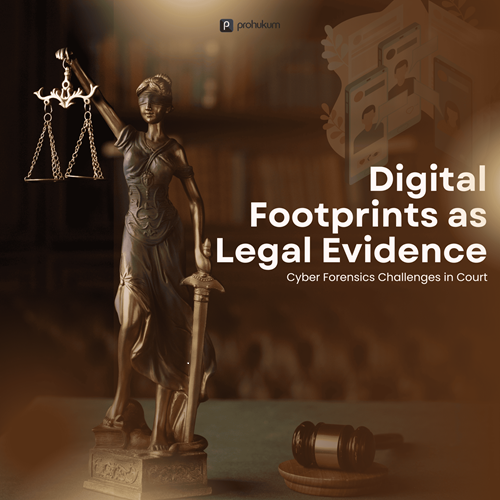In today’s fast paced digital era, our lives are increasingly intertwined with electronic devices and online platforms. For example, everyday activities communication, financial transactions, and work documentation—leave behind digital footprints. Importantly, these digital footprints are now being used as court evidence, playing a crucial role in legal investigations. However, the use of digital footprints as court evidence is not without challenges.

This article explores how law enforcement and judicial authorities utilize digital data in the Indonesian legal system, as well as the cyber forensic obstacles they face.
What Are Digital Footprints?
In simple terms, digital footprints refer to the trail of data generated by users during their digital activities, either actively (e.g., posting on social media, sending emails) or passively (e.g., cookies tracking user behavior). Specifically, these footprints include:
- Emails and instant messages
- Social media history
- GPS location data
- File metadata
- Device activity logs
The Role of Digital Footprints in Legal Evidence
Under Indonesian law, both civil and criminal procedural codes recognize electronic evidence. In particular, the Electronic Information and Transactions Law (UU ITE), along with amendments to the Criminal Procedure Code (KUHAP), explicitly acknowledges the legality of digital data as evidence.
Specifically, Article 5(1) of the UU ITE states that electronic information, electronic documents, and their printed results are legitimate legal evidence. However, for digital evidence to be admissible in court, it must fulfill three key criteria:
- Authenticity : Users or systems must be able to verify that the data has not been altered.
- Relevance : It must have a direct connection to the case.
- Legality : Authorities or investigators must obtain it without violating privacy or other laws.
Cyber Forensics Challenges in Court
Despite legal recognition, digital evidence in Indonesian courts faces several major challenges:
1. Vulnerability to Manipulation
Malicious actors can easily alter digital data. If forensic experts do not follow proper procedures, judges may question the integrity and authenticity of the evidence.
2. Limited Technical Capacity
Many law enforcement officers lack adequate training in digital forensics skills needed to collect, preserve, and analyze digital evidence reliably.
3. Cross-Border Data Access Issues
Some data may be stored on servers located outside Indonesia, requiring international cooperation and Mutual Legal Assistance (MLA) agreements for lawful access.
4. Lack of Standard Operating Procedures (SOPs)
Currently, there is no unified national SOP for handling, verifying, and validating digital evidence, especially in criminal court proceedings.
Case Examples Involving Digital Footprints
- Defamation under the ITE Law
For instance, many defamation cases rely heavily on digital content such as chat messages, social media posts, or screenshots as core evidence.
- Corruption Cases
Digital transaction trails, email logs, and electronic communication records are essential in tracing illicit financial flows and identifying key perpetrators.
Solutions and Recommendations
To improve the effectiveness of digital footprints as legal evidence, the following actions are recommended:
- Capacity-building programs for law enforcement in digital forensics
- Development of clear national guidelines for handling electronic evidence
- For example, cross-agency collaboration (e.g., BSSN, National Police, Ministry of Communication and Information, Supreme Court) is essential for effective handling of digital evidence.
- Public awareness campaigns on digital security and cyber law
Conclusion
Using digital footprints as legal evidence marks a transformative shift in how justice systems pursue fairness in the digital age. Indeed, electronic evidence no longer serves merely as complementary proof instead, it acts as the primary evidence in cases ranging from online defamation to cybercrime and white-collar offenses.
Thanks to the legal foundation provided by the ITE Law and the recognition of digital documents within Indonesia’s judicial framework, law enforcement is now becoming more adaptive to technological developments. However, the practical application of digital evidence still faces serious hurdles—such as a lack of technical expertise, procedural inconsistencies, jurisdictional conflicts, and the ever-present risk of data manipulation.
To overcome these challenges, Indonesia needs a unified digital forensics framework, stronger institutional capacity, and greater legal-technical synergy. If implemented properly, these measures will ensure that digital footprints are no longer just traces of online activity—they will instead become pillars of a more transparent, responsive, and inclusive justice system.
Ultimately, in the future, justice won’t rely solely on eyewitnesses and paper documents. Instead, it will also depend on the digital footprints we leave behind each day.
